[am4show have='p156;p157' guest_error='guest_error_msg' user_error='user_error_msg' ]
We're going to dive into fractions and see how it's everywhere around us! It shows up in the kitchen when you bake, at the hardware store when you cut wood to size, at the restaurant where you share a pizza with your friends. Let's get started!
How much work is expected?
Expect to do at least 5-15 minutes of math practice every day (longer if you are enjoying it). This consistent practice will improve your skills and create a sense of progress and enthusiasm for math. Make math a regular practice, just like brushing your teeth.
Once you have reached a level of consistent daily practice, it’s time for slower-paced, more in-depth work in addition to quick math practice, for a total of 30 – 45 min per day.
We will have in-class activities, at-home games, labs, scavenger hunts, and mental math to mix into your daily practice as a review of the material you have mastered. If you find something particularly challenging, do a quick practice until it smooths out again.
You should have effortless use of your math skills so these 'stumbles' don’t get in the way when you work with more advanced topics. We’ll give you plenty of options for these during our time together.
Download your Fractions #1 Workbook
I've prepared a special set of four workbooks for you to help you master the concepts we cover in class. Plan to complete 4-5 pages per day. After you complete the pages, you may check the answer key. (You can use these or your own workbooks as long as they cover fractions.)
Fractions Workbook #1: Parts 1-2
I've put together a set of videos that will walk you through this workbook, so grab yours and let's work together. There are four videos that cover Workbook #1, and you'll find the rest of the videos in the next session. Plan to complete 4-5 pages per day. After you complete the pages, you may check the answer key.
Reading & Using a Tape Measure
People have been measuring things forever, but it wasn't until the 1820s when the spring tape measure was developed using leftover wire from women's hoop skirts (which used about 180 feet of wire per dress!). A tape measure (or measuring tape) is a flexible ruler that can bend, and it's one of the most important tools engineers, scientists, builders and other professionals use to do their work. It can look confusing when you first look at one, so let's learn how to read it easily using fractions!
Intermediate Level Math Class
If you already understand the main concept of a fraction and would like practice using your new skills, this is the perfect level for you. You can Run an Ice Cream Shop, do a Math Scavenger Hunt, and enjoy a Math Game in Dominoes!
NOTE: Please be sure you know how to read a tape measure! If you need to learn or need practice, scroll up and watch the Using a Tape Measure video and do the practice problems!
In Class Activity: Ice Cream Shop
During class, we will start an activity together. You can work through the entire activity on your own, but if you'd like to do it alongside me, use the two videos below.
Math Scavenger Hunt!
The best way to learn how to get comfortable with fractions is to actually use them! Here is a fun activity you can do this week after you finish the Ice Cream Lab above.
Math Games: Fraction Dominoes
If you need extra practice with getting to know fractions, especially if they are new to you, try out this math game! It's fun, easy and all you need is the printout and a pair of scissors!
Advanced Level Math Class
More advanced students will discover practical applications by learning how to read the scale of photographs and calculate how large objects are in the real world based on your measurements and information you have in your photo. We'll talk about scales smaller than 1 by looking at insects, larger than 1 by looking at large structures like buildings and bridges, and also huge objects like our sun.
Advanced Math Labs: Projects
This week I've put together two different labs, one is called Forensic Faces and the other is Standard Units. You can opt to either one or both. We will post solutions and instructional videos on how to solve the Blue Whale, Andean Condor, and Harpy Eagle labs on Thursday if you need a little help.
Additional Math Problems (for Advanced Students)
We have four more math problems in the field of Astrophysics! These astronomy problems will use fractions to solve the problems. Here are the step-by-step instructional videos of the complete solutions for all four problems.
Math Challenge
Each session, I have a special Math Challenge for you to work on after you work through some of the content in this area of math. The goal for these special math challenges is for you to be able to communicate your great ideas with your family and friends, without them being in a math class or having any knowledge of a specific area of math. You should be able to convey your great ideas to most people that are interested in hearing what you have to share. Many families find this part of the math program exciting for them to participate in with their student!

Are you having trouble with your multiplication table?
If you're struggling with your 12-times table, copy down this table or print out a copy and have it right in front of you during class and while you're working on your workbooks. You'll find it easier to spot patterns if you are actively using this table, and for some students, having this visual makes a big difference. If your child needs addional help with their math skills, click for further resources.

[/am4show]

